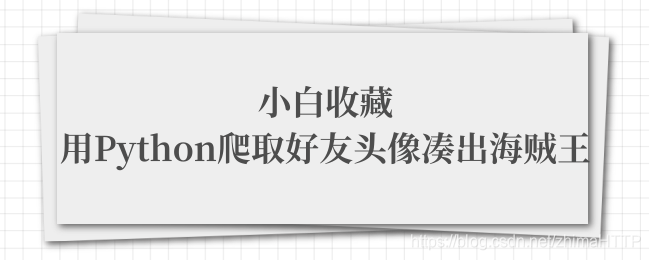
Hoy compartiré con ustedes el uso de Python para rastrear los avatares de amigos y juntar todos los avatares en una imagen de One Piece.
El código general:
de PIL import Image
import os
import numpy as np
from tqdm import tqdm
Configuración de clase:
corp_size = 40
filter_size = 20
num = 100
clase PicMerge:
def __init__(self, pic_path, mode='RGB', pic_folder='wechat'):
if mode.upper() not in ('RGB', 'L'):
raise ValueError('Only accept "RGB" or "L" MODE, but we received "{}".'.format(self.mode))
else:
self.mode = mode.upper()
print('Coding for every picture in folder "{}".'.format(pic_folder))
self.mapping_table, self.pictures = self.mapping_table(pic_folder)
self.picture = self.resize_pic(pic_path).convert(self.mode)
@staticmethod
def resize_pic(pic_path):
picture = Image.open(pic_path)
width, height = picture.size
to_width = Config.corp_size * Config.num
to_height = ((to_width / width) * height // Config.corp_size) * Config.corp_size
picture = picture.resize((int(to_width), int(to_height)), Image.ANTIALIAS)
return picture
def merge(self):
width, height = self.picture.size
w_times, h_times = int(width / Config.corp_size), int(height / Config.corp_size)
picture = np.array(self.picture)
print('Corp & Merge...')
for i in tqdm(range(w_times), desc='CORP'):
for j in range(h_times):
if self.mode == 'L':
section = picture[j * Config.corp_size:(j + 1) * Config.corp_size,
i * Config.corp_size:(i + 1) * Config.corp_size]
section_mean = section.mean()
candidate = sorted([(key_, abs(np.array(value_).mean() - section_mean))
for key_, value_ in self.pictures.items()],
key=lambda item: item[1])[:Config.filter_size]
most_similar = self.structure_similarity(section, candidate)
picture[j * Config.corp_size:(j + 1) * Config.corp_size,
i * Config.corp_size:(i + 1) * Config.corp_size] = most_similar
elif self.mode == 'RGB':
section = picture[j * Config.corp_size:(j + 1) * Config.corp_size,
i * Config.corp_size:(i + 1) * Config.corp_size, :]
candidate = self.color_similarity(section)
most_similar = self.structure_similarity(section, candidate)
picture[j * Config.corp_size:(j + 1) * Config.corp_size,
i * Config.corp_size:(i + 1) * Config.corp_size, :] = most_similar
picture = Image.fromarray(picture)
picture.show()
picture.save('result.jpg')
print('Work Done...')
def structure_similarity(self, section, candidate):
section = Image.fromarray(section).convert('L')
one_hot = self.pic_code(np.array(section.resize((8, 8), Image.ANTIALIAS)))
candidate = [(key_, np.equal(one_hot, self.mapping_table[key_]).mean()) for key_, _ in candidate]
most_similar = max(candidate, key=lambda item: item[1])
return self.pictures[most_similar[0]]
def color_similarity(self, pic_slice, top_n=Config.filter_size):
slice_mean = self.rgb_mean(pic_slice)
diff_list = [(key_, np.linalg.norm(slice_mean - self.rgb_mean(value_)))
for key_, value_ in self.pictures.items()]
filter_ = sorted(diff_list, key=lambda item: item[1])[:top_n]
return filter_
@staticmethod
def rgb_mean(rgb_pic):
"""
if picture is RGB channel, calculate average [R, G, B].
"""
r_mean = np.mean(rgb_pic[:, :, 0])
g_mean = np.mean(rgb_pic[:, :, 1])
b_mean = np.mean(rgb_pic[:, :, 2])
val = np.array([r_mean, g_mean, b_mean])
return val
def mapping_table(self, pic_folder):
"""
What this function do?
1. transverse every image in PIC_FOLDER;
2. resize every image in (8, 8) and covert into GREY;
3. CODE for every image, CODE like [1, 0, 1, 1, 0....1]
4. build a dict to gather all image and its CODE.
:param pic_folder: path of pictures folder.
:return: a dict
"""
suffix = ['jpg', 'jpeg', 'JPG', 'JPEG', 'gif', 'GIF', 'png', 'PNG']
if not os.path.isdir(pic_folder):
raise OSError('Folder [{}] is not exist, please check.'.format(pic_folder))
pic_list = os.listdir(pic_folder)
results = {}
pic_dic = {}
for idx, pic in tqdm(enumerate(pic_list), desc='CODE'):
if pic.split('.')[-1] in suffix:
path = os.path.join(pic_folder, pic)
try:
img = Image.open(path).resize((Config.corp_size, Config.corp_size), Image.ANTIALIAS)
results[idx] = self.pic_code(np.array(img.convert('L').resize((8, 8), Image.ANTIALIAS)))
if self.mode == 'RGB':
pic_dic[idx] = np.array(img.convert(self.mode))
else:
pic_dic[idx] = np.array(img.convert(self.mode))
except OSError:
pass
return results, pic_dic
@staticmethod
def pic_code(image: np.ndarray):
"""
To make a one-hot code for IMAGE.
AVG is mean of the array(IMAGE).
Traverse every pixel of IMAGE, if the pixel value is more then AVG, make it 1, else 0.
:param image: an array of picture
:return: A sparse list with length [picture's width * picture's height].
"""
width, height = image.shape
avg = image.mean()
one_hot = np.array([1 if image[i, j] > avg else 0 for i in range(width) for j in range(height)])
return one_hot
if __ name__ == “__ main__”:
P = PicMerge (pic_path = 'One Piece.jpeg', mode = 'RGB')
P.merge ()
Los anteriores son los pasos específicos, bienvenidos a adoptar.
Parte del contenido del artículo proviene de Internet, intrusión y eliminación de contactos * La
referencia del artículo proviene de http://http.taiyangruanjian.com/news/59274.html